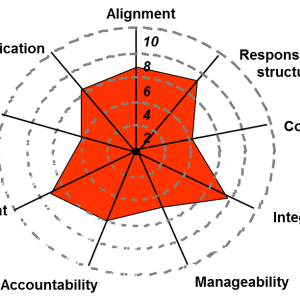By André de Waal and Béatrice van der Heijden
Abstract: There is still a good deal of confusion in the literature about how the use of a performance management system affects overall organizational performance. Some researchers find that performance management enhances both the financial and non-financial results of an organization, while others do not find any positive effects or, at most, ambiguous effects. An important step toward getting more clarity in this relationship is to investigate the role performance management plays in creating and maintaining a high performance organization  (HPO). The purpose of this study is to integrate performance management analysis (PMA) and high performance organization (HPO). A questionnaire combining questions on Performance Management Analysis dimensions and HPO factors was administered to two European-based multinational firms. Based on 468 valid questionnaires, a correlation analysis was performed on the Performance Management Analysis dimensions and the HPO factors in order to test the impact of performance management on the factors of high organizational performance. The results show strong and significant correlations between all the Performance Management Analysis dimensions and all the HPO factors, indicating that a performance management system that fosters performance-driven behavior in the organization is of critical importance to strengthen overall financial and non-financial performance.
(HPO). The purpose of this study is to integrate performance management analysis (PMA) and high performance organization (HPO). A questionnaire combining questions on Performance Management Analysis dimensions and HPO factors was administered to two European-based multinational firms. Based on 468 valid questionnaires, a correlation analysis was performed on the Performance Management Analysis dimensions and the HPO factors in order to test the impact of performance management on the factors of high organizational performance. The results show strong and significant correlations between all the Performance Management Analysis dimensions and all the HPO factors, indicating that a performance management system that fosters performance-driven behavior in the organization is of critical importance to strengthen overall financial and non-financial performance.
Download chapter 1 and 2 of What Makes a High Performance Organization for free (PDF)
Keywords: Performance management, performance-driven behavior, performance management analysis, high-performance organization
Research on the effects of performance management on organizational performance has produced conflicting results (Neely, 2005), suggesting that the impact of performance management is still not well understood (Pavlov & Bourne, 2011). A recent review by De Waal and Kourtit (2013) lists both financial advantages (revenue and profits increase while costs decrease) and non-financial advantages (improved communication, closer collaboration, better knowledge sharing, stronger focus on what really matters and on the achievement of results, better strategic alignment, higher operational efficiency, higher commitment of organizational members, more innovation, higher employe

e and customer satisfaction, and a strengthened organizational reputation). On the other hand, the same review also found disadvantages of using a performance management system, including information overload, too much subjectivity, too much financial and backward-looking information, and an expensive, bureaucratic management approach.
Rangone (1997) remarked that the link between the use of performance measures and organizational effectiveness has been widely recognized but that explanations for this relationship are constrained by the lack of a clear theoretical foundation. Almost two decades later, lack of theory still seems to be an issue, judging from Brudan’s (2010: 110) lament that “the lack of standards regarding the definition, classification and usage of specific tools make both research and application of performance management principles difficult.” Pavlov and Bourne (2011) pointed out that the literature thus far has not demonstrated how performance management systems are linked to overall organizational performance. Choong (2014) takes this viewpoint even further when he says that most researchers in the field of performance measurement have not articulated the performance management system as a complete entity, and because of this we do not have a clear understanding of the interaction of activities of sub-systems within the organization. Moreover, according to Taticchi, Balachandran, and Tonelli (2012), achieving this understanding might be hampered by the fact that there is still a limited understanding of the cause-effect relationships between the performance management system and organizational results. Pavlov and Bourne (2011: 105) concluded that there is still “a black box” that separates performance management from organizational outcomes and that “opening this black box would allow researchers to elucidate the process through which performance management affects performance…” and “in order to understand the mechanism of the impact of performance management on performance, one needs to understand how performance management affects these organizational processes.” An important step toward opening the black box is to investigate the role performance management plays in creating and maintaining a high-performance organization (HPO). An HPO is defined as an organization that achieves financial and non-financial results that exceed those of its peer group over a period of five years or more, by focusing in a disciplined way on what really matters to the organization (de Waal, 2012). In order to create a sustainable HPO, managers and employees alike have to behave in such a way that the objectives and goals of the organization are achieved on a high level. In practice, this implies that the organization’s performance management systems have to be designed in such a way that they provide constructive information and feedback so that organization members can behave in a performance-driven manner.
In this article, we examine the relationship between performance management and the high performance organization using Performance Management Analysis (de Waal, 2010) and the HPO framework (de Waal, 2012). The goal of the empirical study presented here is to evaluate which dimensions of performance management help to create a high-performance organization. This is important to know because the outcomes of such research can be used by organizations to shape their performance management systems which, in turn, will help them in their quest to become and stay a high-performance organization. The article is organized as follows. First, we describe the Performance Management Analysis and the High-Performance Organization frameworks and the theoretical link between them. Then we describe a worldwide study of two companies with roughly comparable performance management systems. Based on the study findings, we offer several recommendations for future research and practice.
Performance Management Analysis
A technique that can be used to assess the impact of performance management in an organization is the Performance Management Analysis  (PMA) (de Waal, 2010). The Performance Management Analysis makes a distinction between structural and behavioral aspects of performance management. The structural aspect refers to the system’s architecture, which needs to be in place in order to use performance management. This usually involves determining Critical Success Factors (CSF) and Key Performance Indicators (KPI) as well as designing a Balanced Scorecard (Kaplan & Norton, 1996). The behavioral aspect refers to the organization’s members and their use of the performance management system. The Performance Management Analysis is based on the principle that the two aspects of performance management, structural and behavioral, need to be given equal attention in order to establish a performance-driven organization. There are many things that can be measured and reported in an organization, but they will be of little value if organization members do not use this information to improve performance. Conversely, goodwill of organization members does not count for much when they cannot access the performance information needed to display performance-driven behavior. The Performance Management Analysis enables an organization to actually assess the degree of performance-driven behavior (Elzinga, Albronda, & Kluijtmans, 2009).
(PMA) (de Waal, 2010). The Performance Management Analysis makes a distinction between structural and behavioral aspects of performance management. The structural aspect refers to the system’s architecture, which needs to be in place in order to use performance management. This usually involves determining Critical Success Factors (CSF) and Key Performance Indicators (KPI) as well as designing a Balanced Scorecard (Kaplan & Norton, 1996). The behavioral aspect refers to the organization’s members and their use of the performance management system. The Performance Management Analysis is based on the principle that the two aspects of performance management, structural and behavioral, need to be given equal attention in order to establish a performance-driven organization. There are many things that can be measured and reported in an organization, but they will be of little value if organization members do not use this information to improve performance. Conversely, goodwill of organization members does not count for much when they cannot access the performance information needed to display performance-driven behavior. The Performance Management Analysis enables an organization to actually assess the degree of performance-driven behavior (Elzinga, Albronda, & Kluijtmans, 2009).
The Performance Management Analysis is a comprehensive survey instrument currently divided into nine dimensions. These dimensions are briefly described below (for a more detailed description see Appendix 1 in PDF link below).
- Responsibility structure (structural dimension): A clear parenting style; tasks and responsibilities have been defined and are applied consistently at all management levels.
- Content (structural): Organization members use a set of financial and non-financial performance information that has a strategic focus (e.g., CSFs and KPIs).
- Integrity (structural): The performance information is reliable, timely, and consistent.
- Manageability (structural): Management reports and performance management systems are user-friendly, and more detailed performance information is easily accessible through ICT systems.
- Alignment (structural): Other management systems, such as the human resource management system, are aligned with performance management, so what is important to the organization is regularly evaluated and rewarded.
- Accountability (behavioral): Organization members feel responsible for the results of the KPIs of both their own responsibility areas and the organization as a whole.
- Management style (behavioral): Senior management is proactive and involved in the performance of organization members and stimulates an improvement culture. At the same time, management consistently confronts organization members who are underperforming.
- Action orientation (behavioral): Performance information is integrated into the daily activities of organization members in such a way that problems are immediately addressed, and corrective or preventive actions are taken.
- Communication (behavioral): Communication about the results (top-down and bottom-up) takes place at regular intervals as well as the sharing of knowledge and performance information between organizational units.
The High Performance Organization
The HPO framework is based on a literature review of 290 academic and practitioner publications about high-performance organizations (de Waal, 2012; de Waal et al., 2014). Out of each of the reviewed publications, elements were identified that the authors regarded as essential to becoming an HPO. Because the authors of the various scholarly contributions often used different terminology, the identified elements were grouped into categories that constituted possible HPO characteristics. For each of the possible HPO characteristics, its weighted importance was calculated (i.e., the number of times that it was mentioned in the publications). Lastly, the possible HPO characteristics with the highest weighted importance were included in an HPO questionnaire that was administered worldwide and included more than 3,200 respondents. In this questionnaire, respondents graded (on a scale of 1 to 10) how well they thought their organizations were performing with respect to the HPO characteristics.
 They also graded their performance results compared to their peer group of organizations. By performing a statistical analysis, we identified 35 characteristics that had the strongest correlation with organizational performance. High-performing organizations scored higher on the 35 HPO characteristics in comparison with low-performing organizations. This means that organizations that pay more attention to these 35 characteristics achieve better results than their peers in every industry, sector, and country across the world. Conversely, organizations that scored low on the characteristics appeared to rank at the bottom of their industry, performance wise (de Waal, 2012).
They also graded their performance results compared to their peer group of organizations. By performing a statistical analysis, we identified 35 characteristics that had the strongest correlation with organizational performance. High-performing organizations scored higher on the 35 HPO characteristics in comparison with low-performing organizations. This means that organizations that pay more attention to these 35 characteristics achieve better results than their peers in every industry, sector, and country across the world. Conversely, organizations that scored low on the characteristics appeared to rank at the bottom of their industry, performance wise (de Waal, 2012).
A factor analysis, performed during the statistical analysis, resulted in the determination of five distinct HPO factors. These five factors are described below (for a more detailed description see Appendix 2 in PDF document below).
- Management Quality.
In an HPO, belief and trust in others and fair treatment are encouraged. Managers are trustworthy; behave with integrity; show commitment, enthusiasm, and respect; and have a decisive, action-oriented decision-making style. Management holds people accountable for their results by maintaining clear accountability for performance. Values and strategy are communicated throughout the organization so that everyone knows and embraces these organizational features. - Openness and Action-Orientation.
HPOs have an open culture, which means that management values the opinions of employees and involves them in important organizational processes. Making mistakes is allowed and is regarded as an opportunity to learn. Employees spend a lot of time on dialogue, knowledge exchange, and learning in order to develop new ideas aimed at increasing their performance and making the organization performance-driven. Managers are personally involved in experimentation, thereby fostering receptivity to change in the organization. - Long-Term Orientation.
An HPO grows through partnerships with suppliers and customers so that long-term commitment is extended to all stakeholders. Job vacancies are filled by high-potential internal candidates, and people are encouraged to become leaders. The HPO creates a safe and secure workplace (both physical and mental) and lays off people only as a last resort. - Continuous Improvement and Renewal.
An HPO compensates for struggling strategies by renewing them and making them unique. The organization continuously improves, simplifies and aligns its processes, and develops new products and services, thereby creating sources of competitive advantage to respond to market changes. Furthermore, the HPO manages its core competencies efficiently and outsources non-core competencies. - Workforce Quality.
An HPO assembles a diverse and complementary management team and workforce with maximum work flexibility. The workforce is trained to be resilient and flexible. Employees are encouraged to develop their skills to accomplish extraordinary results and are held responsible for their performance. As a result, creativity increases, leading to better results.
The HPO framework is built upon the idea that there is a direct and positive relationship between the identified HPO factors and organizational performance: the higher the HPO scores, the better the performance of the organization, and vice versa. An organization can empirically investigate its HPO status by having management and employees fill in an HPO questionnaire and calculating the average scores on the HPO factors. Our own analyses have shown that several characteristics have a direct relation to performance management:
- The organization is performance-driven
- Management focuses on achieving results
- Everything that matters to the organization’s performance is explicitly reported
- Both financial and non-financial information is reported to organization members
- Management inspires and coaches organization members to achieve extraordinary results.
Thus, theoretically, a strong correlation between performance management and a high performance organization can be expected. To evaluate whether this is the case in a particular organization, the performance management system of the organization has to be empirically tested on its ability to support the organization in achieving high performance. This can be accomplished by relating the HPO framework to the Performance Management Analysis.
Theoretical Relationship between the Performance Management Analysis and HPO
Relating the Performance Management Analysis and the HPO frameworks, the first obvious link is in the HPO factor Continuous Improvement and Renewal which contains two characteristics that have to do directly with performance measurement: “In the organization everything that matters to performance is explicitly reported,” and “In the organization both financial and non-financial information is reported to organization members.” The first characteristic matches with the Performance Management Analysis dimension Content while the second characteristic matches with the Performance Management Analysis dimension Manageability. Further, other HPO factors also show theoretical links with Performance Management Analysis. According to the HPO factor Management Quality, in organizations that score high on this, managers are results-oriented, and they deal decisively with non-performers, which matches with the Performance Management Analysis dimensions Responsibility Structure, Accountability, and Management Style. Regarding the HPO factor Workforce Quality, in organizations that score high on this, employees feel responsible for their results, which also matches with the Performance Management Analysis dimension Accountability.
Regarding the HPO factor Openness and Action-Orientation, in organizations scoring high on this, employees spend a lot of time on dialogue, knowledge exchange, and learning in order to make the organization more performance-driven. This matches with the Performance Management Analysis dimensions Action Orientation and Communication. Finally, for the HPO factor Long-Term Orientation, in organizations with a high score on this, there is no obvious link with Performance Management Analysis. However, the argument could be made that an effective performance management system helps maintain and safeguard the sustainability of the organization and thereby its long-term survival.
Research Method
In the present study, the Performance Management Analysis and HPO frameworks were combined into one questionnaire, which was then distributed to two multinational companies operating in Europe. One company is a bank of which the Dutch branch offices participated. The other company is a car rental agency of which the sales offices in five countries (Netherlands, UK, Spain, Germany, France) participated. The performance management systems of both companies were roughly comparable in the sense that:
(a) both systems were designed to capture information from multiple units which was then aggregated to the company level;
(b) in both companies standardized financial and non-financial information was collected and reported, in the form of key performance indicators (KPIs), per month and per quarter, per country, and per office;
(c) many of the KPIs were the same for both companies, and in addition to the obvious financial indicators, non-financial indicators such as customer satisfaction and employee satisfaction were applied in both companies as well; and
(d) the KPI reports were discussed every month at both companies. As such, the performance management systems and their usage were quite homogeneous for both multinational companies.
Sample and Procedure
In the questionnaire, managers and employees of each organization were asked to rate their organization on the 35 HPO characteristics and the nine Performance Management Analysis characteristics, on a scale of 1 (the organization does not satisfy the characteristic at all) to 10 (the organization satisfies the characteristic completely). The scores of all respondents were averaged for the five HPO factors and the nine Performance Management Analysis dimensions. In total, 468 valid questionnaires were received, out of a possible total of 2,024 respondents, resulting in a response rate of 23.1 percent. Using the final valid sample of 468 respondents, a correlation analysis was performed on the HPO factors and the Performance Management Analysis dimensions.
Measures
The reliability of the Performance Management Analysis dimensions and the HPO factors, calculated as Cronbach’s alpha, is shown in Table 1. As can be seen, all Performance Management Analysis dimensions and all HPO factors (with the exception of Workforce Quality) show a high reliability. This means that a relevant correlation analysis can be performed….
Source: Journal of Organization Design JOD, 4(1): 1-11 (2015) DOI: 10.7146/jod.17955
For more information about the HPO Framework, HPO Experts, workshops and our do-it-yourself HPO Insight™ improvement tool, please contact us (schreurs@hpocenter.com or T. +31 (0) 35 – 603 70 07).


